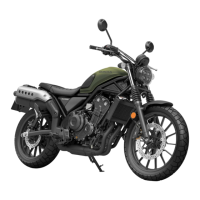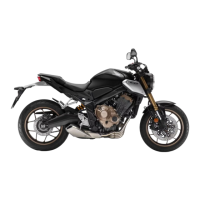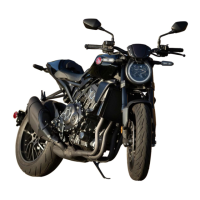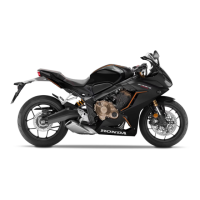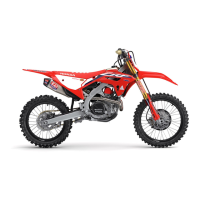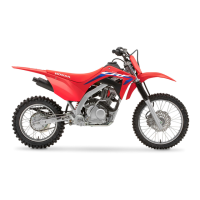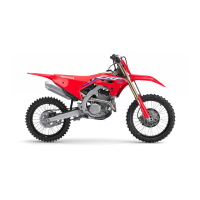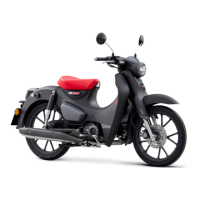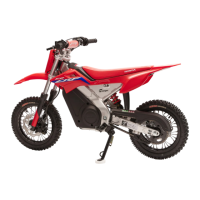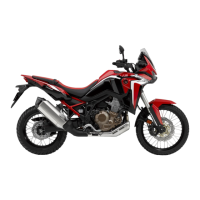Do you have a question about the Honda CL500A 2022 and is the answer not in the manual?
General welcome to the owner and overview of country-specific codes.
Essential guidelines and precautions for safe riding and operation.
Meanings and interpretations of various safety labels on the vehicle.
Guidelines for safe riding, accessories, and loading.
Identification of key motorcycle components and their locations.
Explanation of dashboard instruments, indicators, and display functions.
Operation and function of motorcycle switches, controls, and ignition.
Procedures for starting the engine, shifting gears, and emergency signals.
Steps for refuelling, closing fuel cap, and using storage equipment.
Rationale for maintenance and the recommended service schedule.
Basic principles and procedures for vehicle maintenance.
Procedures for maintaining engine oil, coolant, brakes, clutch, tyres, and chain.
Steps for removing and installing body components like battery, seat, and covers.
Diagnosing and resolving problems with engine starting.
Understanding and responding to dashboard warning lights.
Troubleshooting electrical issues and blown fuses.
Addressing tyre punctures and other common vehicle problems.
Information on vehicle keys, ignition, cut-off, and clutch systems.
Guidelines for cleaning, protecting, and environmental responsibility.
Procedures for storing, transporting, and key vehicle specifications.
Technical details and dimensions of the vehicle's main parts.
Key service data, recommended fluids, and tyre information.
General welcome to the owner and overview of country-specific codes.
Essential guidelines and precautions for safe riding and operation.
Meanings and interpretations of various safety labels on the vehicle.
Guidelines for safe riding, accessories, and loading.
Identification of key motorcycle components and their locations.
Explanation of dashboard instruments, indicators, and display functions.
Operation and function of motorcycle switches, controls, and ignition.
Procedures for starting the engine, shifting gears, and emergency signals.
Steps for refuelling, closing fuel cap, and using storage equipment.
Rationale for maintenance and the recommended service schedule.
Basic principles and procedures for vehicle maintenance.
Procedures for maintaining engine oil, coolant, brakes, clutch, tyres, and chain.
Steps for removing and installing body components like battery, seat, and covers.
Diagnosing and resolving problems with engine starting.
Understanding and responding to dashboard warning lights.
Troubleshooting electrical issues and blown fuses.
Addressing tyre punctures and other common vehicle problems.
Information on vehicle keys, ignition, cut-off, and clutch systems.
Guidelines for cleaning, protecting, and environmental responsibility.
Procedures for storing, transporting, and key vehicle specifications.
Technical details and dimensions of the vehicle's main parts.
Key service data, recommended fluids, and tyre information.
| Displacement | 471 cc |
|---|---|
| Compression Ratio | 10.7:1 |
| Fuel System | PGM-FI electronic fuel injection |
| Starter | Electric |
| Transmission | 6-speed |
| Final Drive | Chain |
| Rear Tire | 150/70-17 |
| Seat Height | 790 mm |
| Curb Weight | 192 kg |
| Fuel Capacity | 12 L |
| Engine Type | Liquid-cooled, 4-stroke, DOHC, 4-valve, parallel twin cylinder |
| Bore x Stroke | 67 mm x 66.8 mm |
| Max Power Output | 34.3 kW @ 8, 500 rpm |
| Max Torque | 43.4 Nm @ 6, 250 rpm |
| Front Suspension | 41 mm telescopic fork |
| Rear Suspension | Twin shock absorbers with preload adjustment |
| Front Brakes | Single 310 mm disc with two-piston caliper |
| Rear Brakes | Single 240mm disc with single-piston caliper, ABS |
